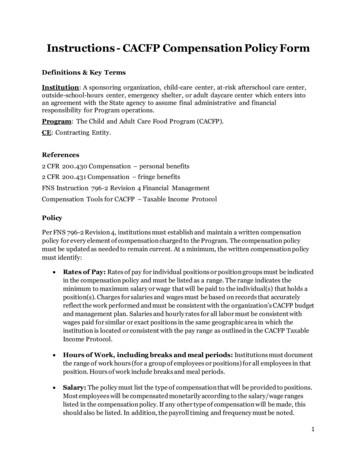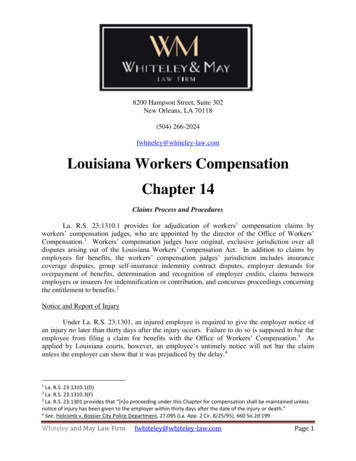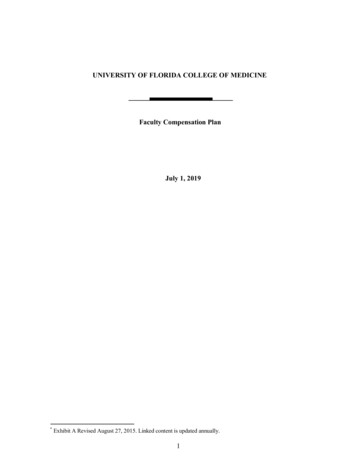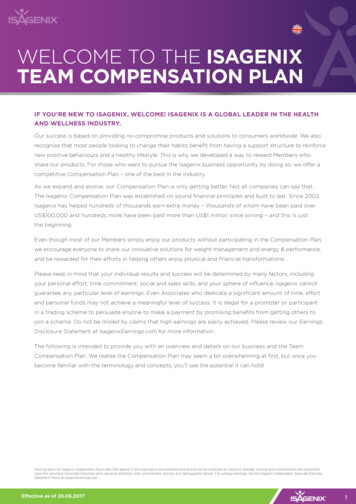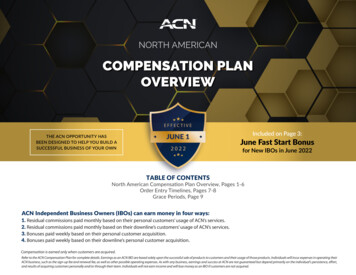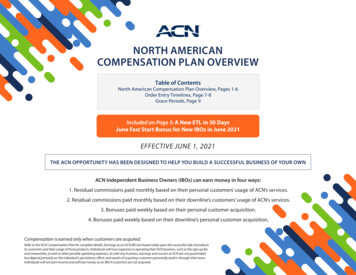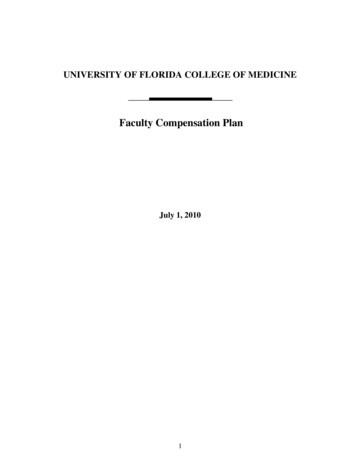
Transcription
UNIVERSITY OF FLORIDA COLLEGE OF MEDICINEFaculty Compensation PlanJuly 1, 20101
Table of ContentsIntroduction . 3Base Salary . 3Faculty Assignments and Performance Scores . 4Performance Standards and Evaluations . 6Teaching Evaluation. 6Individual Teaching Incentive. 7Research Evaluation . 9Individual Research Incentive . 10Service Evaluation . 13Administrative Supplements . 13Patient Care Evaluations . 14Individual Clinical Incentive . 15Veterans Health Administration . 16Year-end Departmental Incentive . 17Endowments . 18Compensation Plan Database . 18Timeline . 18Resolution of Conflicts and Grievances . 19Exhibit I: Performance Standards . 20Exhibit II: Examples . 22Exhibit III: Compensation Benchmarks . 23Exhibit IV: Medical Productivity Benchmarks . 32Exhibit V: Timeline. 352
INTRODUCTIONThe major goals of the University of Florida (UF) College Of Medicine (COM) facultycompensation plan are to promote and reward individual success in teaching, research, service andpatient care through monetary incentives and individual recognition.The compensation plan covers both clinical and basic science faculty employed by theCOM. All faculty employed in salaried, benefits-eligible positions participate except: (1) facultyreporting to COM leadership in Jacksonville (COM faculty employed at the Jacksonville regionalcampus are covered under a separate compensation plan), (2) OPS and Emeritus faculty, (3)postdoctoral associates and research associates, (4) visiting faculty, (5) Advanced Registered NursePractitioners and Physician Assistants, and (6) faculty specifically exempted by the Dean.A new faculty member who is employed after the first business day of the fiscal year may beincluded in the plan if the position is included in the department’s annual budget and has been givenan appropriate assignment and, for clinical faculty, a wRVU target.This compensation plan is subject to periodic review by the COM Compensation Committeeand revision by the Dean to ensure that the goals of the plan are being met. Without revising theplan, incentive payments or other elements of this plan may be suspended in specific cases wherethe College of Medicine faces financial exigency, as determined by the Dean. Standing research andclinical subcommittees of the Compensation Committee are available to make recommendations tochairs or the Dean, as appropriate, about disputes, conflicts, or questions surrounding facultycompensation.BASE SALARYBase salary is a faculty member’s fixed contracted salary. Base salary may be adjustedannually in accordance with UF and COM guidelines and based on the faculty member’sperformance. If performance measures are achieved or exceeded, faculty will be eligible for a basesalary increase, incentives, and/or a year-end departmental incentive.Base salary, also referred to as “Fixed/Contractual Salary Plus Medical PracticeSupplement” in the AAMC Faculty Salary Survey, will be subject to an established floor andceiling, stratified for rank and specialty (EXHIBIT III). A faculty member’s base salary cannot bereduced below the AAMC 20th percentile, and cannot exceed the AAMC 75th percentile. It is theintent of the COM to provide appropriate total compensation without inflating base salary. Whenannual faculty salary increases are authorized by UF or the COM, faculty above the 75th percentilemay be granted a payment in lieu of a base salary adjustment. Other external benchmarks in lieu ofthe AAMC 75th percentile ceiling may be used with the approval of the Dean. For basic science3
faculty and PhD’s in clinical departments, base salary is subject to the AAMC 20th percentile floorbut not the ceiling.Total compensation is comprised of base salary, administrative supplements, productivityincentives, year-end departmental incentives, and one time payments. Total compensation may notexceed fair market value. In order to receive an incentive payment, a faculty member must beemployed with the College of Medicine in a faculty position through June 30th of the current year.Base salary increases associated with faculty promotions and the UF Salary Pay Plan (SPP)will be made in accordance with University of Florida and COM guidelines.FACULTY ASSIGNMENTS AND PERFORMANCE SCORESAll faculty are assigned an academic home department responsible for their annualevaluation. If faculty have major responsibility in another area, a Center for example, the homedepartment chair should communicate with the appropriate supervisor from that area regarding thefaculty assignment and evaluation.The department chair, or appropriate designee, must define faculty job expectations andestablish full time equivalent (FTE) assignments for each faculty member, as well as performancemeasures for each assignment. A faculty member's FTE assignments should accurately reflect thework effort of the faculty member. Performance measures appropriate for faculty rank andopportunity are determined with input from the faculty member.When residents or medical students are present during clinical work, clinical FTE’s may bereallocated 80% patient care and 20% teaching to provide credit for instructional activity. Forteaching FTE’s, instructional hours and number of students taught are used to align FTE withresponsibilities. The FTE assigned to research cannot be less than the ratio of all salary paid byresearch grants and research contracts divided by base salary.Faculty members with assignment to the Veterans Health Administration (VHA) will beassigned an FTE value that reflects net time commitment to the VHA. VHA appointments arebased on 40 hours of work per week, which represents an 8/8ths appointment to the VHA. Duringscheduled VHA hours, a faculty member cannot participate in COM activities.At the time of their annual evaluation, faculty members must demonstrate that they met theirassigned performance measures for the year. A rating system will be used for performance,assigning a grade for each activity (1 to 5, 5 best score) and adjusting the score for assigned FTE.The weighted scores for all activities will determine the final performance score as shown in thetable below. Grades will be rounded to the nearest tenth decimal place.4
Chairs may increase or decrease the grade in any one mission by up to 1.0 point to reflectprofessionalism, attitude, enthusiasm, willingness to volunteer, attendance at meetings, participationas a team player, and similar characteristics and contributions.MissionFTE PercentGradeScoreTeachingResearchServicePatient CareVeterans Health AdministrationTotal100 %Faculty are eligible for annual base salary and merit increases, incentives, and year-enddepartmental incentives based upon the faculty member’s total performance score as referenced inthe table below. Such increases must be in accordance with UF and COM guidelines.Faculty who receive an annual evaluation rated at the below performance standard level orat the unsatisfactory performance level are subject to annual reductions in base salary. In suchsituations, the effective date of base salary reductions will be determined by the Dean.OverallPerformance ScoreOutcome4.5 to 5.0Outstanding performance. Eligible for base salary andmerit increase, incentive, and year-end departmentalincentive.*4.0 to 4.4Exceeds performance standard. Eligible for base salaryand merit increase, incentive, and year-end departmentalincentive.*3.0 to 3.9Achieves performance standard. Eligible for base salaryand merit increase, and incentive.2.0 to 2.9Below performance standard. Up to 5 percent base salaryreduction. Not eligible for incentive or year-enddepartmental incentive.0.0 to 1.9Unsatisfactory performance. Up to 10 percent base salaryreduction. Not eligible for incentive or year-enddepartmental incentive.*Higher performance scores may result in higher merit increases and year-enddepartmental incentives.5
PERFORMANCE STANDARDS AND EVALUATIONPerformance will be tied to academic benchmarks and evaluated by objective data wheneverfeasible. Departments will develop performance measures for each mission that can be used tobenchmark and establish a base score. If a faculty member’s assignment changes during the yearbecause of new or altered assignments, such changes must be approved by the Dean anddocumented in writing to the faculty member.TEACHING EVALUATIONMeasures of teaching performance are based on data that will be provided by the COM,course, clerkship and residency program directors, and individual faculty members. Productivity ismeasured in teaching hours, numbers of students taught, service on teaching committees, anddevelopment of teaching aids. Teaching productivity should correspond to the FTE assigned toteaching.Quality is to be measured by student, resident and peer evaluations and by teaching awards.The following table provides a guideline for grading teaching performance.Grade4.5 to 5.04.0 to 4.43.0 to 3.92.0 to 2.90.0 to 1.9QualityRecognized for teaching excellence by students, residents, or peers. Demonstratesteaching leadership by distinguished service on UFCOM education committees or asa course, IDP director, clerkship, or residency program director. Responsible for andachieves continuing residency accreditation. Promotes education programs atregional or national meetings. Receives outstanding teaching awards.Readily accepts teaching responsibilities, produces materials, and works with othersto improve educational programs. Achieves above average performance ratings fromstudents, residents or peers.Participates in assigned teaching responsibilities with average performance ratings asidentified by students, residents, course or residency program director, IDP director,chair, or Associate Dean for Education.Performs below expectation for assigned teaching responsibilities as indicated bypoor evaluations from student, resident, or peers, or by failure to performassignments on time.Does not accept teaching responsibilities when asked or accepts with reluctanceand/or fails to follow through on assignments.6
INDIVIDUAL TEACHING INCENTIVETo recognize outstanding performance in teaching, an incentive may be available from theCOM Office of the Dean for a select number of educators. Eligible faculty will be nominated fromeach department and participate in a college-wide competition to receive an incentive. Faculty areselected based on the excellence of their teaching of medical students, residents and fellows,graduate students, post-docs, and mentorship of other faculty.To qualify for an award of excellence in teaching, candidates must have an teaching grade of4.5 or better, no grade less than 3.0, and a teaching assignment of at least 15%. If extenuatingcircumstances exist such that a department chair believes a particular faculty member deservesconsideration for the award with less than 15% time assigned to teaching, the nomination canproceed with a request to the selection committee to excuse the 15% teaching assignmentrequirement. Department chairs and members of the selection committee are not eligible for theteaching incentive.Each department may nominate one or more faculty meeting the criteria referenced above.The maximum number of nominations by a department will be based on the department’s assignedteaching FTE. This number is determined by calculating the sum of the teaching FTE assignmentof faculty in each department for the academic year. This total by department is rounded up to thenext whole number.The department chair must approve all nominees and either rank order or categorize thosesubmitted for the incentive awards as outstanding, excellent, or very good. The teaching portion ofthe department chair’s annual evaluation letter will be used to support nominated individuals, or aseparate letter from the chair may be issued. As the primary support document, the evaluation lettermust include a summary of the candidate’s teaching activities, emphasizing teachingaccomplishments, and evaluations of medical students, residents and fellows, graduate students,post-docs, and mentored junior faculty. The evaluation letter must also include the candidate'sperformance grades for all assigned missions. Nominated applicants should review their evaluationletter for completeness prior to submission.The selection committee will judge teaching excellence based on the quality of teaching, asassessed by teaching and peer evaluations, teaching effort, and a candidate’s teachingaccomplishments. The committee will determine which of the nominated faculty receive awards,with the goal to select the top 10% of COM educators.7
The selection committee shall be comprised of the following individuals:1. Senior Associate Dean for Education or designee, serves as chair of the selectioncommittee.2. Associate Dean for Graduate Education.3. Associate Dean for Medical Education.4. Associate Dean for Graduate Medical Education.5. Chair of the College of Medicine Curriculum Committee.6. Faculty member appointed by Society of Teaching Scholars.7. Basic Science Department Chair appointed by the Dean.8. Clinical Department Chair appointed by the Dean.9. President of the Faculty Council or his/her designee.Incentive awards. The minimum and maximum awards will be determined by fundsavailable. The selection committee may recommend to the Dean the monetary value of the awards.Exemplary Teacher Awards. Faculty receiving incentive awards will be recognized asExemplary Teachers at the Educational Week Banquet held during the spring semester.8
RESEARCH EVALUATIONMeasures of research performance are based on objective data that will be collected by theCOM or provided by the individual faculty member. Faculty members with 0.20 FTE or greaterassigned to research, or assistant professors during their initial employment for up to five years with0.30 FTE or greater assigned to research, are expected to have the research portion of their basesalary derived from research grants. For these faculty members, grant awards and salary offsetsfrom grants will be used to calculate incentives (as described below) and will determine the researchfunding component score which will be 60% of the research grade.The second component (40%) of the grade is research outcomes. Outcome measures arebased on conduct and progress of research, publications, presentations, recognized achievements inresearch, and meeting or exceeding individual annual research goals.The grade for faculty members with 0.20 FTE and for assistant professors (in their firstfive years) with 0.30 assigned to research will be based solely on research outcomes, includingprogress toward meeting/exceeding expectations for publications, presentations, and participation inresearch activities locally or nationally.The following table provides guidelines for assessing research accomplishments. Thedepartment chair or designee will establish specific performance measures for an individualfaculty’s research FTE, according to rank and opportunity, with faculty input. Research scores willbe determined for each of the two components and the final grade will be a weighted average of theresearch funding (60%) and the research outcomes (40%) category scores.GradeResearch Funding (60%)Research Outcomes (40%)Supports research FTE* salary onresearch grants or contracts.Far exceeds expectations/yearly goals forpresentations, publications, patents, andconduct of research. Achieved or buildingnational reputation, e.g., service on studysection/research advisory group, visitingprofessor/invited speaker, or similar peerrecognition. Receives research achievementawards.Serves as PI or Co-I on research grantswith some salary support. Alternatively,has secured 75% or more of researchFTE* from grants/contracts or start-upfunds.Exceeds expectations/yearly goals forpresentation, publications, patents, andconduct of research. Solid and promisingresearch progress with appropriate handlingof problems.4.5 to 5.04.0 to 4.49
3.0 to 3.9Meets expectations for grant applicationswith at least one grant with priority scorenear funding range or with an improvedscore on resubmission. Alternatively, hassecured 50% or more of research salaryfrom grants/contracts or start up funds.Submits abstracts, papers and patents asappropriate. Conduct and progress ofresearch is satisfactory and meetsexpectations.2.0 to 2.9Submits/participates in grant applicationsbut with scientific priority scoressubstantially out of funding range. Hasmade good effort to secure funding butwithout success.Makes no sustained effort to present orsubmit available work for publication.Conduct and progress of research is slow anddoes not meet expectations/yearly goals.0.0 to 1.9Fails to submit or participate in grantapplications with salary support. Fails toobtain funding in a timely manner.Makes no effort to present or submitavailable work for publication. Conduct andprogress of research is minimal.* An individual’s support of their research FTE may be less than support of their full salary forthose faculty whose salary is above federal grant salary caps (e.g., NIH).INDIVIDUAL RESEARCH INCENTIVETo participate in the individual research incentive, a faculty member must have 0.20 FTEtime assigned to research and an assistant professor (for up to five years or until promotion toassociate professor, whichever occurs first) must have 0.30 FTE assigned to research. However,department chairs can request approval of the Dean for participation in the individual researchincentive by faculty with FTE 0.20 or by assistant professors with FTE 0.30 who, in spite oftheir small amount of time dedicated to research, have obtained grant support for their researchsalary.To provide an incentive for faculty to seek salary support from research grants, thepercentage of research FTE salary covered by grants will be used to calculate a research incentiveaccording to the table below. For the purpose of the incentive, research salary support will beprovided primarily by extramural, peer-reviewed grants. Research grants and research contracts,including industry sponsored research, count towards the research incentive if they specify salarysupport and are awarded with indirect costs. Salary paid by a research career development award,including VA mentor research training programs, is included in the incentive. For salary offsets tocount towards the research incentive, the faculty member must be the principal investigator, coprincipal investigator or a co-investigator who has made a significant intellectual contribution to thegrant application as determined by the chair after consultation with the principal investigator.10
Incentives for grant supported salaries are calculated as a percent of base salary allocated toresearch per the table below. For faculty whose salary rate exceeds a cap determined by a fundingagency (e.g., NIH cap on salary), determination of the research grade and the incentive will bebased upon the FTE assigned to the grant (relative to the faculty member’s total FTE assigned toresearch), not the actual amount of funding awarded by the granting agency for that FTE.Base Salary Covered by GrantsAdjusted for Research FTEIncentive as a Percent of Base SalaryAllocated to Research50% or more60% or more75% or more90% or more2.03.04.56.0If a faculty member qualifies for an incentive and the calculated award is less than 250, theactual award he/she would receive is 250.To provide incentives for newly appointed assistant professors who are developing aresearch program, recognizing that it is often difficult for these individuals to secure the level offunding indicated above, the following will apply. For up to five years as an assistant professor oruntil promotion to associate professor, the table below will be used to calculate the facultymember’s incentive. To participate in this program, an assistant professor must have 30% timeassigned to research. (Department chairs can request approval of the Dean for participation in theindividual research incentive by assistant professors with FTE 0.30 who have 20% or more oftheir research salary supported by grants.)Base Salary Covered by Grants forqualified Assistant ProfessorsAdjusted for Research FTEIncentive as a Percent of SalaryAllocated to Research 20%2.030% or more3.045% of more4.560% or more6.0Additional incentives will be given to promote and reward investigator-initiated, peerreviewed, competitive, large-scale research grant/contract awards. To encourage large grants thatinvolve multiple investigators such as Program Projects and Center grants, in which eachinvestigator contributes a separately funded project or a separate project with a dedicated budget,additional research incentives are also provided. Incentives are given for each year of the research11
award, for grant/contract expenditures to UF that specify salary support for the principal (PI) or leadinvestigator and pay indirect costs, in accordance with the table below:Research ActivityPI or lead investigator on a competitive, peer-reviewed Program Project,center or comparable multiple grant award, with direct costs greater than 750,000 per year.PI or lead investigator on a competitive, peer-reviewed training grant,with direct expenditures greater than 100,000 per year.Incentive as Percentof Salary Charged toResearch Grant63PI or lead investigator on investigator-initiated, competitive, peerreviewed grant(s), including subproject(s) of a competitive, peer reviewedProgram Project, center or other multiple grant award(s) with total directexpenditures: 100,000 per year4 500,000 per year5 1,000,000 per year6 2,000,000 per year7PI on VA Merit Review Award with direct expenditures of 150,000 andat least a 5/8 appointment to the VHA. 1,500Incentive payments will be pro-rated for grants less than 150,000.The incentive that accrues to the investigator will be calculated and paid semi-annuallybased on the actual amount of salary charged against the grants (i.e., if a grant was open for ninemonths, but salary was charged to the grant for only two months, then only two months of salaryoffset would be used to calculate the incentive amount). Fringe benefits will not be paid onincentives.To ensure that balance between assigned departmental missions is maintained, eligibility forthe research incentive requires a performance rank of 3.0 or better in all mission categories.12
SERVICE EVALUATIONService activities in teaching, research, or patient care should be assigned to that mission.Other service activities include such duties as senior/associate/assistant deanships, departmentchairs, associate/assistant chairs, division chiefs, medical directors, service or educational contractadministrators/directors, UF, COM and department committee membership / leadership.Performance measures will be developed by the appropriate supervisor and faculty.The following table provides a guideline for assessment of service performance.Service EvaluationGrade4.5 to 5.0Serves in key administrative positions with demonstrated leadership as judged fromunit operation consistent with budget and respectful of personnel. Demonstratesorganizational skills. Serves in elected or appointed administrative position outsideUFCOM consistent with its mission.4.0 to 4.4Exceeds expectations in most but not all areas. Promotes cooperation with colleaguesand clearly supports department and college objectives.3.0 to 3.9Meets administrative expectation. Attends meetings and contributes to objectives.2.0 to 2.9Accepts responsibilities but performance is lacking. Does not follow through onassignments and demonstrates minimal progress on goals. Often absent fromcommittee meetings.0.0 to 1.9Does not accept administrative responsibilities when asked.ADMINISTRATIVE SUPPLEMENTAn administrative supplement may be provided for significant administrativeresponsibilities. Administrative supplements are considered part of a faculty member’s base salary.When a faculty member’s administrative assignment ends, any administrative supplementassociated with that assignment is removed from the faculty member’s base salary. One-timepayments paid to faculty members for activities such as additional duty or responsibilities aretemporary and are not included in base salary.13
PATIENT CARE EVALUATIONPatient care is evaluated on measures of productivity and quality of care. Work relativevalue units (wRVUs), compared to target, define one performance measure for clinical productivity.For those faculty whose clinical FTE is 0.20 or greater, 75% of the base grade for clinicalperformance will be assigned by the COM, based on how actual productivity compares to theassigned wRVU target as indicated in the table below.Clinical Productivity and QualityGradeProductivity (75%)Quality and Safety (25%)4.5 to 5.0Exceeds wRVU target by 25percent or moreGreatly exceeds performance standardsdetermined at annual evaluation4.0 to 4.4Exceeds wRVU target by atleast 10 percentExceeds performance standards determinedat annual evaluation3.0 to 3.9Meets expectationMeets performance standards determinedat annual evaluation2.0 to 2.9Falls below wRVU target by Performs slightly below performanceat least 15 percentstandards determined at annual evaluation0.0 to 1.9Falls below wRVU target by Fails to meet performance standards30 percent or moredetermined at annual evaluationBase grades will be calculated using a sliding scale between 1 and 5 as shown above.The chair may request an adjustment in the base grade for approved medical leaves ofabsence or other circumstances beyond the control of an individual faculty member.The chair assigns 25% of the grade based on quality of care, using measures previouslyagreed to during the faculty member’s annual evaluation meeting. These may include measurablequality markers, a 360 evaluation, collegiality, physician and patient satisfaction surveys, medicalrecord completion, and ongoing professional practice evaluations. Input from the departmentalquality officer is anticipated. The timeliness, adequacy, and accuracy of information provided forpatient billing may also be considered.For faculty whose clinical service is supported by salary cost reimbursement from acontract, the grade for this service will be determined based on how well the individual fulfills theterms of the contract, as determined by the chair using assigned performance measures. If such14
individuals also have an additional clinical assignment, the overall clinical grade will beproportioned based on FTE assigned to contract versus total clinical FTE.For faculty with less than 0.20 FTE assigned to patient care activities, the chair willdetermine a faculty member’s grade based on the faculty member achieving his/her assignedperformance measures.INDIVIDUAL CLINICAL INCENTIVEThe chair will define, with input from the faculty member, annual work RVU targets. (In theunusual situation where wRVUs targets are inappropriate, a chair may request the Dean to approvean alternative method of assigning or calculating clinical productivity targets.) In determining thetargets, chairs will take into consideration base salary allocated to clinical activities, cli
compensation plan are to promote and reward individual success in teaching, research, service and patient care through monetary incentives and individual recognition. The compensation plan covers both clinical and basic science faculty employed by the COM. All faculty employed in salaried, benefits-eligible positions participate except: (1) faculty
